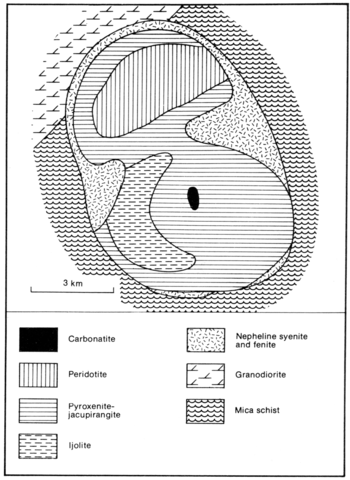stripes
The complex of Jacupiranga is an oval-shaped intrusion of 65 km2 emplaced in mica schists and granodiorites of the Precambrian Acungui Group, which are fenitized and nephelinized in places. The central area of the northern half of the complex comprises a peridotite of partly serpentinized olivine (Fo40) which grades outwards into more pyroxene-rich rocks and then into an ijolite-jacupirangite series. As nepheline increases so the pyroxene changes from augite to sodic pyroxene. In the centre of the southern half of the complex is a carbonatite plug surrounded by jacupirangites of titanaugite and magnetite, but with a little nepheline and biotite. This was intruded on the western side by a crescent-shaped area of ijolites. Around the northern margin is an area of fenites and nepheline syenites which broaden in the central area of the complex. The nepheline syenites as well as the fenites are considered to be metasomatic by Melcher (1966, p. 170). Dykes of essexite, ijolite, monchiquite and tinguaite occur. There are few petrographic data available on the silicate rocks at Jacupiranga, but the carbonatites have been described in some detail (Melcher, 1965 and 1966). The carbonatite forms an elongated body of five distinct intrusions forming northern and southern sectors (Gaspar and Wyllie, 1983a, Fig. 1) in an area of about 1000x250 m which is expressed topographically as the hill of Morro da Mina, which has a pronounced karst topography. Contacts with the enclosing jacupirangite dip steeply outwards and jacupirangite xenoliths can be found throughout. The carbonatites are predominantly white, medium to coarse grained sovites often with flow banding defined by magnetite, olivine and phlogopite-bearing layers. The minerals present are calcite, dolomite, apatite, magnetite, forsterite, serpentine, clinohumite, phlogopite, pyrite, pyrrhotine, galena, ilmenite, pyrochlore, baddeleyite, baryte and perovskite. Zones of dolomitization of the sovite can be observed in the apatite quarry. The mineralogy of the five intrusive phases distinguished by Gaspar are detailed in Gaspar and Wyllie (1983a, Table 1), and the Sr and Nd isotopic compositions of minerals separated from these phases have been investigated by Roden et al. (1985). Alvikite and beforsite dykes are widespread. Detailed descriptions of barium phlogopite, magnetite and ilmenite will be found in Gaspar and Wyllie (1982, 1983a and 1983b) and of ilmenite and titanium clinohumite in Mitchell (1978). Melcher (1965) provides some data on other accessory minerals as well as distribution maps for some major oxides.
AMARAL, G. 1978. Potassium-argon age studies on the Jacupiranga alkaline district, State of Sao Paulo, Brasil. Proceedings of the First International Symposium on Carbonatites, Pocos de Caldas, Brasil: 297-302.
DEANS, T. 1978. Mineral production from carbonatite complexes: a world review. Proceedings of the First International Symposium on Carbonatites, Pocos de Caldas: 123-33.
GASPAR, J.C. and WYLLIE, P.J. 1982. Barium phlogopite from the Jacupiranga carbonatite, Brazil. American Mineralogist, 67: 997-1000.
GASPAR, J.C. and WYLLIE, P.J. 1983a. Magnetite in the carbonatites from the Jacupiranga complex, Brazil. American Mineralogist, 68: 195-213.
GASPAR, J.C. and WYLLIE, P.J. 1983b. Ilmenite (high Mg, Mn, Nb) in the carbonatites from the Jacupiranga complex, Brazil. American Mineralogist, 68: 960-71.
MELCHER, G.C. 1965. O carbonatito de Jacupiranga. Boletim, Facultade de Filosofia, Ciencias e Letras, Universidade de Sao Paulo, Geologia, 21: 1-75.
MELCHER, G.C. 1966. The carbonatites of Jacupiranga, Sao Paulo, Brazil.In Carbonatites, O.F. Tuttle and J. Gittins (Eds), John Wiley, New York: 169-81.
MITCHELL, R.H. 1978. Manganoan magnesium ilmenite and titanian clinohumite from the Jacupiranga carbonatite, Sao Paulo, Brazil. American Mineralogist, 63: 544-7.
RODEN, M.F., RAMA MURTHY, V. and GASPAR, J.C. 1985. Sr and Nd isotopic composition of the Jacupiranga carbonatite. Journal of Geology, 93: 212-20.
RODRIGUES, C. de S. and LIMA, P.R.A. dos S. 1984. Carbonatitic complexes in Brazil. Companhia Brasileira de Metalurgia e Mineracao, 1-17

